|
|
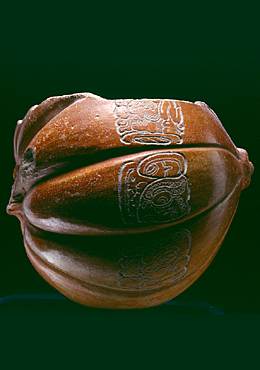
|
The earliest food-serving container in Mesoamerica was the gourd or calabash. It pre-dates the domestication of maize (prior to 5000 BC) and remains in use throughout Mexico. During the Preclassic and Classic periods, artisans carved and painted containers made from gourds and calabashes, although these organic objects usually do not survive in the archaeological record. Classic period artists also made replicas from ceramic and stone, such as this ceramic vessel.
Squash Effigy Vessel. |
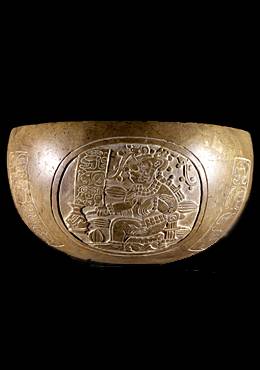
|
The color and shape of this limestone bowl mimic drinking vessels made from the calabash. The incised images include hieroglyphic texts separating three cartouches, each containing a figure and text. One cartouche features the god of cacao, his body spouting cacao pods, who points to a jar likely filled with cacao drink.
Carved Bowl |
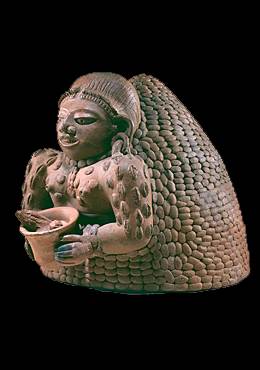
|
One of the most highly valued crops of the Pacific slopes of southern Guatemala was cacao. Representations of cacao are preserved in ceramics from this region, often in the form of incense burners or lidded cache vessels. This lid is modeled in the form of a young woman who holds a small bowl filled with cacao pods. She emerges from a pile of cacao beans, once used as a form of curency.
Censer Lid in Form of Female Holding Cacao |
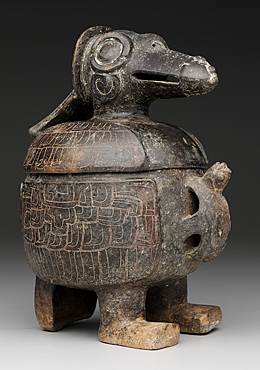
|
The Maya elite served a frothy cacao drink during feasts. The importance of these gatherings dictated the use of elaborate service vessels such as this unusual lidded container in the form of a cormorant with a tiny turtle attached to its breast.
Vessel in Form of Cormorant |
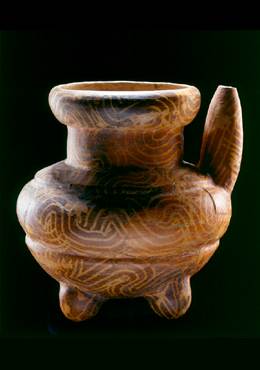
|
Cacao had a prominent place at feasts, lending prestige to the feast's host and giving pleasure to his guests. It was created by mixing ground cacao beans, water, flavorings, and a sap-based foaming agent, and then pouring the liquid from vessel to vessel to produce a heady froth. During the Preclassic, spouted jars and tall cylinder vessels were used during feasts to prepare and serve cacao drinks.
Spouted Vessel |
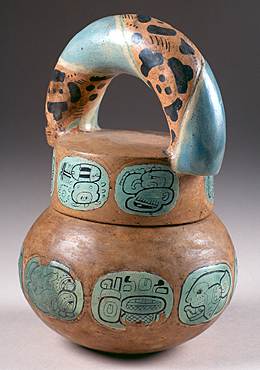
|
Vessels filled with cacao also were placed in tombs to provide sustenance for the deceased in the afterlife. The vessel depicted here was found in the burial of an aristocratic man at Río Azul. This tomb was dug into bedrock underlying the platform that supported an early funerary temple perhaps asscociated with Río Azul's tenth ruler.
Lidded Vessel and Stand (catalog and website only) |
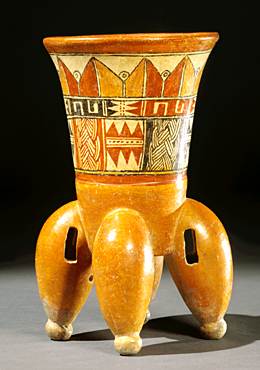
|
During the Early Classic period, artists eschewed the complex modeling of Preclassic vessels in favor of more simplified forms intricately embellished with incised and, especially, painted imagery. The change was gradual, its first manifestations combining Preclassic features (modeled knobs and tall, mammiform supports or "feet," as seen here) with simpler Early Classic forms (cylindrical vases and wide plates with flat bottoms) that were then painted with complicated, symbolic designs.
Tripod Vessel |
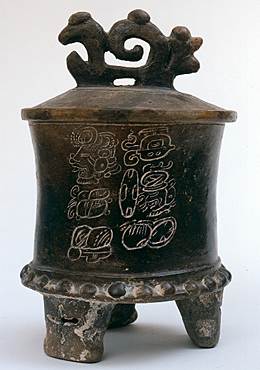
|
Artists also developed individual painting styles that conveyed distinction and status to both the regal patron and the gift recipient. Often, the name and noble parentage of the patron or recipient was recorded on the vessel, as is the case with this lidded vessel with hieroglyphic text.
Lidded Tripod Vessel with Hieroglyphic Text |
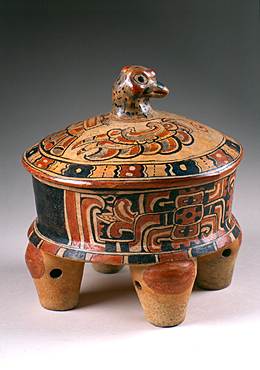
|
This four-footed dish with a bird-effigy lid was among the offerings found in a burial at Tikal's Mundo Perdido complex, which was the residential and administrative center of Tikal until AD 378. The vessel was found in the burial of an infant, who was adorned with greenstone jewelry. The burial was below the floor of Structure 5D-84, the northernmost shrine of the complex's E-Group, an assemblage of buildings associated with ancestral veneration rites.
Lidded Dish with Bird-Head Knob |
top home |
Copyright 2005 Los Angeles County Museum of Art